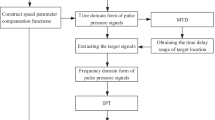Abstract
The steered covariance matrix (STCM) and its inverse matrix should be calculated in each beam for steered minimum variance (STMV). The inverse matrix needs complex computation and restricts its application in engineering. Combining the integration character of one-phase regressive filter with the iterative formula of inverse matrix, an STMV iterative algorithm is proposed. The computational cost of the iterative algorithm is reduced approximately to be 2/M times of the original one when there are M sensors, and is more advantaged for the realization of the algorithm in real time. Simulation results show that the STMV iterative algorithm can preserve the characters of STMV on high azimuth resolution and weak target detection while the computational cost reduced sharply. The analysis on sea trial data proves that the proposed algorithm can estimate each target’s azimuth even when the source powers differ in large scales or their bearings are very approximate.
Similar content being viewed by others
References
Van Trees H L. Optimum array processing (IV) [M]. New York: John Wiley & Sons, 2003.
Xu Hai-dong. The research on the technology of high discrimination bearing estimation based on vector array [D]. Harbin: College of Underwater Acoustic Engineering, Harbin Engineering University, 2004 (in Chinese).
Guo Qi-li, Sun Chao, Yang Yi-xin. Design of broadband beamformers based on an excepted response interpolation technique [J]. Chinese Journal of Acoustics, 2006, 31(4): 328–333 (in Chinese).
Agrawal M, Prasad S. DOA estimation of wideband sources using a harmonic source model and uniform linear array [J]. IEEE Transactions on Signal Processing, 1999, 47(3): 619–629.
Wang H, Kaven M. Coherent signal-subspace processing for the detection and estimation of angles of arrival of multiple wideband sources [J]. IEEE Transactions on ASSP, 1985, 33(4): 823–831.
Chen Hua-wei, Zhao Jun-wei. Coherent signal subspace wideband optimal beamforming for acoustic vector-sensor array [J]. Chinese Journal of Acoustics, 2005, 30(1): 76–82 (in Chinese).
Hui Juan, Hu Dan, Hui Jun-ying, et al. Researches on the measurement of distribution image of radiated noise using focused beamforming [J]. Chinese Journal of Acoustics, 2007, 32(4): 356–361 (in Chinese).
Mei Ji-dan, Hui Jun-ying, Hui Juan. Measurement of underwater acoustic image positions using a horizontal linear array with focused beam-forming [J]. Chinese Journal of Acoustics, 2007, 28(7): 773–778 (in Chinese).
Yan She-feng, Ma Yuan-liang, Hou Zhao-huan. Broadband high-resolution direction-of-arrival estimation using beamspace coherent signal subspace approach [J]. Chinese Journal of Acoustics, 2006, 31(5): 418–424 (in Chinese).
Krolik J, Swingler D. Multiple broadband source location using steered covariance matrices [J]. IEEE Transactions on Acoustics, Speech and Signal Processing, 1989, 37(10): 1481–1494.
Zhang Xian-da. The analysis and application of matrix [M]. Beijing: Tinghua University Press, 2004 (in Chinese).
Author information
Authors and Affiliations
Corresponding author
Rights and permissions
About this article
Cite this article
Zhu, Dz., Li, Gf., Hui, Jy. et al. Iterative algorithm of steered minimum variance and its application in weak targets detection. J. Shanghai Jiaotong Univ. (Sci.) 15, 694–701 (2010). https://doi.org/10.1007/s12204-010-1071-6
Received:
Published:
Issue Date:
DOI: https://doi.org/10.1007/s12204-010-1071-6
Key words
- beamforming
- steered minimum variance (STMV) iterative algorithm
- computational cost
- weak target detection




